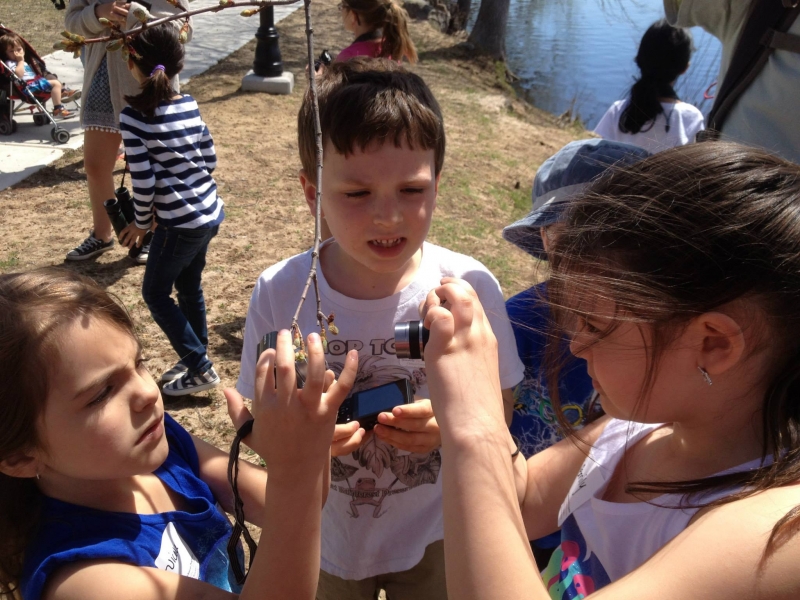
Sun Time and Screen Time: Infusing Technology in Outdoor Experiences
 Technology has been around for ages!
Technology has been around for ages!
The use of a fishing rod can be traced back to 2000 BC1, the first plows were used around 4000 BC, and a granary to store excess food was built in 6000 BC2. Even as far back as the Stone Age there is evidence that humans were applying knowledge and using tools to solve problems3. All of these feats can be filed under the overarching term technology whose definition ranges from the use of tools and applied ingenuity, to digital devices like computers and televisions.
However, in recent history our culture has radically changed the ways we interact with the world and with technology. With smartphones, televisions, and computers, we are spending more and more time staring at screens rather than getting outdoors. Richard Louv4, author of Last Child in the Woods, hypothesizes that children today are suffering from what he calls nature-deficit disorder. This means children are not getting the physical and mental health benefits of spending time outside, leaving them instead with more behavioral problems and apathy towards the environment. According to the Kaiser  Family Foundation5, “8-18 year-olds devote an average of 7 hours and 38 minutes (7:38) to using entertainment media across a typical day (more than 53 hours a week),” leaving little time for outdoor play. With such a strong decline in direct nature experiences and an enormous increase in screen time, we seem to be losing touch with the environment we live in. Which leads me to ask:
Family Foundation5, “8-18 year-olds devote an average of 7 hours and 38 minutes (7:38) to using entertainment media across a typical day (more than 53 hours a week),” leaving little time for outdoor play. With such a strong decline in direct nature experiences and an enormous increase in screen time, we seem to be losing touch with the environment we live in. Which leads me to ask:
Are our nature experiences going extinct?
In his book Technological Nature: Adaptation and the Future of Human Life,6 Peter Kahn argues: yes. “We are losing patterns of interaction with nature that have sustained us for tens of thousands of years, and which contribute deeply to our flourishing as individuals and as a species,” Kahn states. Not only are we losing the experiences, but they are fundamental to our welfare – a dangerous combination.
Fortunately, there has been a widespread trend to promote the benefits of outdoor time for children and to get kids back outside. One teacher has started “Forest Mondays”7 at her school in Quechee, Vermont where students spend the entire day outdoors to learn from nature. Additionally, groups like Tinkergarten8, a community of teachers sharing and coordinating outdoor lessons for tots, have also sprung up. Not to mention the programs like Robert Moses Nature Center's and Adirondack Mountain Club’s school outreach9 and our Nature Up North K-12 programs right here in the North Country.

Nonetheless, technology is not going away.
Is it possible for the technology we have available and the natural world we live in to coexist? The answer is yes! Many of us have probably experienced an impossible to read phone screen in the sunshine, or the annoying ringtone going off on an otherwise peaceful woods walk, but technology and nature can complement each other if used correctly. Pursuing the many possibilities new technology offers is an excellent way to extend our engagement with the environment and provides us with the resources to learn more about it than ever before. With a tap of our finger we can have an app identify a tree, use GPS to find a trail, or read about hundreds of species we might encounter.
If we view technology as a bonus rather than a replacement we can see that outside our wired up houses there is a home to discover. So take your tech with you and go explore it!
Here are just a few great ways you can infuse technology in your outdoor exploration:
- Nature Photography – bring your camera, smartphone or tablet and take some photos of the beautiful landscapes and wildlife in your area. There is no shortage of things to photograph and everyone can participate. Afterwards you can share with your friends by posting your encounters online here.
- Letterboxing and Geocaching – search for treasure and explore new places. Whether you are looking for a fun family event or an individual quest, these activities are great places to find it. Letterboxing revolves around someone placing a “letterbox”, a small container holding a homemade stamp and a log book, and posting clues online so others can find it. Similarly, geocaching involves hiding a cache full of knickknacks to be discovered by GPS.
- Outdoor Apps – there are dozens of new apps for your smartphone that make it easy to get outside and expand your understanding of things you might find. For a list of our favorite outdoor apps be sure to check out 10 Best (FREE) Apps for the Outdoor Enthusiast.
Bibliography:
- Herd, Andrew. "A short history of the fishing rod." The Fishing Museum Online. 2011.
- "History of Agricultural Technology." The National Agribusiness Technology Center. 2009.
- Wayman, Erin. "Becoming Human: The Origin of Stone Tools." Smithsonian. 2012.
- Louv, Richard. Last Child in the Woods :Saving our Children from Nature -Deficit Disorder. 1st ed. Chapel Hill, N.C.: Algonquin Books of Chapel Hill, 2005.
- "Generation M2: Media in the Lives of 8- to 18-Year-Olds." Kaiser Family Foundation. 2010.
- Kahn, Peter H. Technological Nature: Adaptation and the Future of Human Life. Cambridge, Mass.: MIT Press, 2011. E-book.
- Hanford, Emily. "Out Of The Classroom And Into The Woods." NPR. 2015.
- "Tinkergarten." Tinkergarten Inc. 2015.
- "School Outreach." Adirondack Mountain Club. 2015.

